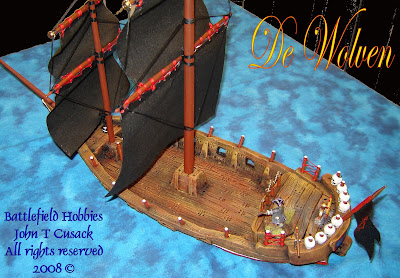In this installment, I will demonstrate how to add wood and clay supports that will help strengthen your ship.
 Roll a long thick lump of clay about 3-4 inches in length. Cut this into the shape shown in the picture.
Roll a long thick lump of clay about 3-4 inches in length. Cut this into the shape shown in the picture. Blend the clay into the side and main deck for each piece.
=> Detail each piece with vertical wood grain, and a rivet at the top and bottom of the support.
 Measure and cut wood posts for supports. You will need only two for this section. My posts are 1-1/4 inch in lenght.
Measure and cut wood posts for supports. You will need only two for this section. My posts are 1-1/4 inch in lenght.=> In total I will use 26 posts on this ship.
I have added some character to the post by carving a grove at one end and sanding the tip to make it round. Customizing the post is tedious work, yet the finish results are worth the effort.
 From the coffee stir sticks, measure and cut two trapezoid shaped planks. Cut the angle on the first, then set a second stir stick on the cutting board. Cut the next piece by following the angle of the first trapezoid plank. The result will be two matched trapezoid planks that fit on the face of the foremast post.
From the coffee stir sticks, measure and cut two trapezoid shaped planks. Cut the angle on the first, then set a second stir stick on the cutting board. Cut the next piece by following the angle of the first trapezoid plank. The result will be two matched trapezoid planks that fit on the face of the foremast post.Place two of the skewers posts at an angle, gently pushing them into the main deck.
=> Do not push them all the way thru the deck. In case you do push them too far, just remember to sand them a bit after you bake the model. The ship will have a felt bottom, so you do not need to concern yourself too much.
 Cut more coffee stir sticks as in the last step, with three planks for each side. You may then use round posts as above or use flat craft sticks as shown in the photo.
Cut more coffee stir sticks as in the last step, with three planks for each side. You may then use round posts as above or use flat craft sticks as shown in the photo.Add wood posts:
Either way, custom posts or standard post, you will insert them into the stern, gently pushing and twisting them in place.
Add four left, and four right of the flag staff. Use the dental compactor tool to make a pilot hole for each post. Notice that I insert the stern posts about half of the length.
Add two additional posts, left and right of the quarterdeck. The posts are inserted no more than 1/3 of theier length into the clay.
You could also make these four quarterdeck posts a touch longer, as needed to ensure they are inserted at least 1/2 inch into the clay.
=> Later I will show you how to create a guardrail between these two posts.
Gaming Note: This ship has eight posts across the stern, used to mount skull marker beads. The skull beads are used within The Pirates Code - No Quarter Given, Fast Play Rules system 2008 ©, by Battlefield Hobbies. The skull markers are use to track the speed of the ship. Each skull represents 1-knot of speed, which equals 10cm of movement for navigation.
=> You can use the skulls to track damage, speed or just add them for effect.
Add posts for effect:
=> For my ships, these extra posts are used to tie off ropes, or to store the skull beads when the ship slows below 8-knots of speed.
Add as many additional wood posts or supports to help customize your ship. The extra posts can be for show, or have a specific function as needed.
Historical note:
Ruse de guerre: Most pirate ships would carry an assortment of flags. A common ploy used by pirates would be to raise the national flag of the merchant vessel that they are approaching to trick them into letting down their guard. The pirates would then approach the target vessel, getting in close enought to bring their deck guns into range. The pirates would then host up the Jolly Roger, and firing a warning shot across the bow, thus letting their true intentions be known. The pirates do not want to shoot up thier intended prey, and many times the only shot fired is the warning shot, and Woe to any merchant that ignores the warning. Pirates forced to fight for their spoils, are more likley to offer No Quarter in combat. For this reason, a wise or defenceless merchant vessel would often strike their colors, surrendering to the mercy of the pirates.

- NOTE: You can make a variety of pirate flags and national ensigns. This will allow you to swap out flags as needed. De Wolven for example, is a Dutch name, so you could add a Dutch VoC or a standard Dutch flag and quickly turn her into a merchant vessel in disguise.
The VoC : Vereenigde Oost-Indische Compagnie, which translates as United East Indies Company but is also known as the Dutch East India Company.
Vereenigde Oost-Indische Compagnie, which translates as United East Indies Company but is also known as the Dutch East India Company.
In the 1600's the VoC dominated navigation and world trade.
=> In a future post I will cover making flags with canvas, or with 110lbs card stock.
Concluding part 7:
This will conclude part SEVEN of the Pirate ship build.
In the next installment I will cover the final steps before baking the clay.
- Stop by my Flickr or Picasa photo pages for pictures of other completed ships, pirate, privateer and naval vessels.

















No comments:
Post a Comment